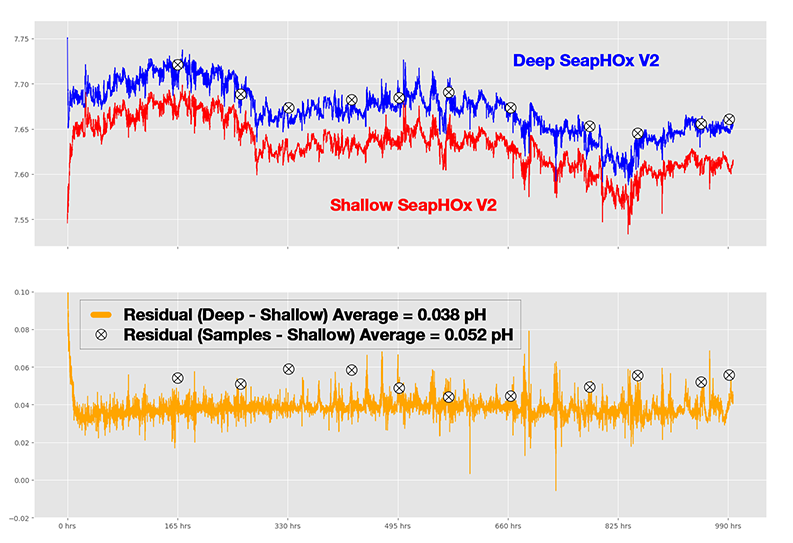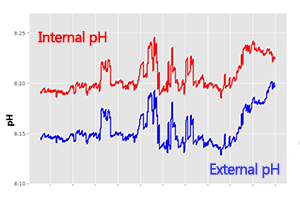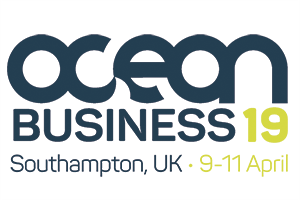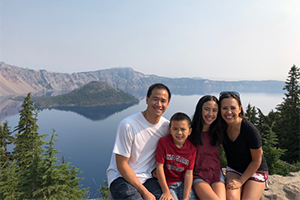- PRODUCTS
- MODEL LIST
- APPLICATIONS
- SUPPORT
- SALES/SERVICE
- BLOG
- ABOUT
March 2019 Newsletter

High Residuals in pH Data
The data shown above come from a SeapHOx V2 (red) and Deep SeapHOx V2 (blue) deployed next to one another in a dynamic estuarine environment. Regular pH validation samples were collected throughout the time-series. According to the 0.05 pH accuracy spec of each sensor, there really isn’t much to be concerned about: both sensors agree with one another within spec (sensor residual average = 0.038 pH) and the overall gap between each sensor’s data is minuscule compared to standard glass electrodes. Furthermore, the difference between validation samples and the Shallow SeapHOx V2 is within spec when considering the accuracy of the samples themselves. That being said, ISFET pH sensors can and should do better, and recent optimizations in Sea-Bird Scientific’s calibration process show that this is true.
Learn More
The data shown above come from a SeapHOx V2 (red) and Deep SeapHOx V2 (blue) deployed next to one another in a dynamic estuarine environment. Regular pH validation samples were collected throughout the time-series. According to the 0.05 pH accuracy spec of each sensor, there really isn’t much to be concerned about: both sensors agree with one another within spec (sensor residual average = 0.038 pH) and the overall gap between each sensor’s data is minuscule compared to standard glass electrodes. Furthermore, the difference between validation samples and the Shallow SeapHOx V2 is within spec when considering the accuracy of the samples themselves. That being said, ISFET pH sensors can and should do better, and recent optimizations in Sea-Bird Scientific’s calibration process show that this is true.
Learn More

Internal and External References on the SeaFET V2
The SeaFET V2 and Shallow SeapHOx V2 have two reference electrodes—the Internal Reference and the External Reference—each providing a unique pH value. Last month’s newsletter showed a problem where the internal reference provided faulty data while the external reference was clean. So what’s the difference between the two, and which value should you ultimately report?
Find Out Here
The SeaFET V2 and Shallow SeapHOx V2 have two reference electrodes—the Internal Reference and the External Reference—each providing a unique pH value. Last month’s newsletter showed a problem where the internal reference provided faulty data while the external reference was clean. So what’s the difference between the two, and which value should you ultimately report?
Find Out Here

We are going to Ocean Business '19
Sea-Bird Scientific is exhibiting at Ocean Business'19 at Southampton UK in April. Visit us at Stand L9 to talk about your applications and find an instrument package that best fits your needs. We are excited to provide six focused training sessions at the conference. Join our experts as we present key topics ranging from new technological developments to products that serve as the industry standard for oceanographic sensors.
Topics We'll Cover
Sea-Bird Scientific is exhibiting at Ocean Business'19 at Southampton UK in April. Visit us at Stand L9 to talk about your applications and find an instrument package that best fits your needs. We are excited to provide six focused training sessions at the conference. Join our experts as we present key topics ranging from new technological developments to products that serve as the industry standard for oceanographic sensors.
Topics We'll Cover

Meet our People: Calvin Lwin, Technical Sales Director
Calvin received his Electrical Engineering degree from Santa Clara University, where he was on a senior design project team that built an underwater ROV that was used by NOAA’s National Undersea Research Program. He joined Sea-Bird in 2006 and is currently the Technical Sales Director focused on working with Sea-Bird’s team of Sales/Applications Engineers and international sales representatives to consult with customers and recommend the best sensor solutions for specific applications. When he’s not working, Calvin enjoys spending time with his wife and two kids travelling, camping, and enjoying the outdoors as a family.
Open Positions
Calvin received his Electrical Engineering degree from Santa Clara University, where he was on a senior design project team that built an underwater ROV that was used by NOAA’s National Undersea Research Program. He joined Sea-Bird in 2006 and is currently the Technical Sales Director focused on working with Sea-Bird’s team of Sales/Applications Engineers and international sales representatives to consult with customers and recommend the best sensor solutions for specific applications. When he’s not working, Calvin enjoys spending time with his wife and two kids travelling, camping, and enjoying the outdoors as a family.
Open Positions

